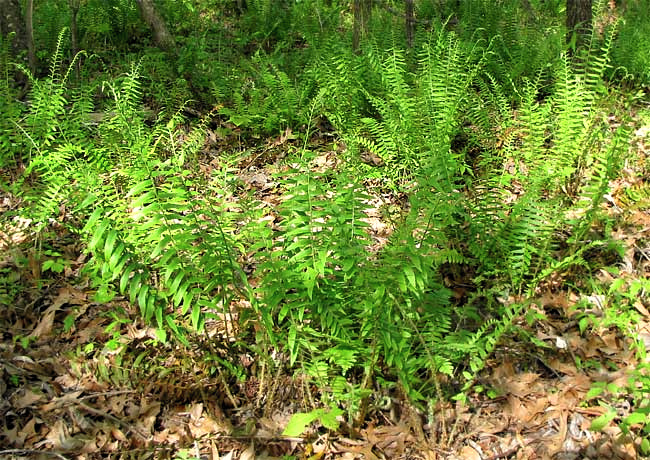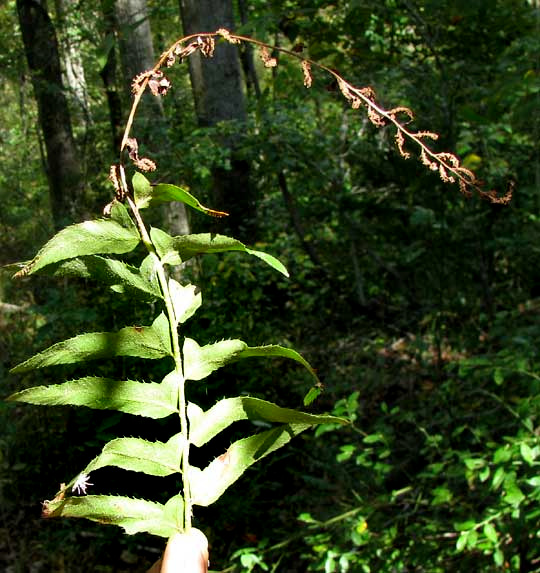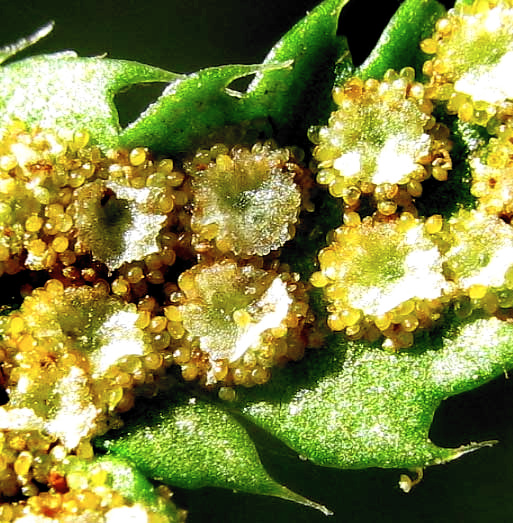Excerpts from Jim Conrad's
Naturalist Newsletter

from the March 2, 2009 Newsletter, issued from the forest near Natchez, Mississippi; elevation ~400ft (120m), ~N31.47°, ~W91.29°:
CHRISTMAS FERNS UNFURLING
Christmas Ferns, POLYSTICHUM ACROSTICHOIDES, as indicated above, are abundant throughout our upland oak/pine woods and since their large, dark-green fronds last throughout the winter nowadays they form very conspicuous clumps of greenery emerging from the forest floor's brown leaf litter. This week it's been warm enough -- sometimes into the low 80s
-- for some but not all of the ferns to issue their fiddleheads, as shown below:

"Fiddleheads" is the correct name for the emerging fronds, as you can see at the left in the above picture. As is typical for ferns, the fronds unfurl as they emerge. However, as the frond on the right shows, not all unfurling fronds always assume the classic fiddlehead form.
You can see that Christmas Fern fiddleheads are pretty shaggy affairs. A couple of nights after the above picture was taken the temperature dropped below freezing and I'll bet the fuzziness kept many new fronds from being frostbitten.
For, the fronds are actually fairly tender. In fact, I've read that in the old days people gathered them at this stage and cooked them as you might asparagus. I've tried that and found the fuzziness a bit unpalatable, plus the fronds themselves were a little bitter. However, during hard times hungry people would be glad to have them.
from the November 1, 2009 Newsletter, issued from the forest near Natchez, Mississippi; elevation ~400ft (120m), ~N31.47°, ~W91.29°:
THE CHRISTMAS FERN'S CURIOUS FERTILE FRONDS
When I passed through here last March the Christmas Ferns' fronds didn't show a hint of the future sori beneath their "fertile fronds" -- sori being clusters of spore-producing sporangia. Now you can see the fertile fronds bearing mature sporangia below:

The curious thing about the fertile, sori-bearing fronds of Christmas Ferns is that the sori are limited to frond divisions, or pinnae, at the tip of the frond, and those "fertile pinnae" are considerably smaller than the pinnae below them not bearing sori. Moreover, once the spores are released, the small fertile pinnae shrivel up and turn brown, as the photo shows. Sometimes students think that the fertile pinnae are diseased or somehow damaged.
A few fertile pinnae still bear sori with immature sporangia. A fine picture of those can be admired below:

This picture shows very nicely an important field mark for ferns of the big, very common genus Polystichum -- the sori's indusia (the shiny, round, cellophane-like sheets partially covering each sorus) are attached to the frond at their centers, like umbrellas.
Of course in that picture each spherical, yellowish item emerging at the indusia's edges is a baglike sporangium which, when mature, will split open to release many spores. They're not the spores themselves, but they contain the spores.
from the February 2, 2003 Newsletter, issued from near Natchez, Mississippi:
CHRISTMAS FERNS
I've mentioned how in places our forest floor is covered with ferns, and that our two most abundant ferns are the Southern Shield-fern and the Christmas Fern. Last week's 15°
(-9.4°C) caused most fronds of the Southern Shield-fern to collapse into brown messes
(new ones will emerge in a few weeks), but Christmas Fern fronds remain healthy looking and green as ever, and are thus especially conspicuous now.
Christmas Ferns are so named because they used to serve as green decoration during the Christmas season. The name makes more sense farther north where fewer green things can be found at that season. Really you have to admire this species. Not only is it tough enough to survive deep freezes, but also it inhabits a very large area -- from Nova Scotia and Wisconsin to Florida and Texas, and in Mexico. Moreover, throughout its distribution it's often the most common species. If you want to know the name of just one wild fern, you'll get the most mileage knowing this one.